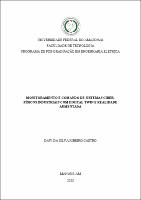| ???jsp.display-item.social.title??? |


|
Please use this identifier to cite or link to this item:
https://tede.ufam.edu.br/handle/tede/9873| ???metadata.dc.type???: | Dissertação |
| Title: | Monitoramento e comando de sistemas ciber-físicos industriais com digital twin e realidade aumentada |
| Other Titles: | Monitoring and control of industrial cyber-physical systems with digital twin and augmented reality |
| ???metadata.dc.creator???: | Castro, Davi da Silva Ribeiro  |
| ???metadata.dc.contributor.advisor1???: | Lucena Júnior, Vicente Ferreira de |
| First advisor-co: | Bessa, Iury Valente de |
| ???metadata.dc.contributor.referee1???: | Medeiros, Renan Landau Paiva de |
| ???metadata.dc.contributor.referee2???: | Silva, Vandermi João da |
| ???metadata.dc.description.resumo???: | O Digital Twin (DT) consiste em um modelo virtual que tem como concepção replicar um processo físico em tempo real, permitindo a simulação de diversas condições e análise de desempenho. Já a Realidade Aumentada (RA) é uma tecnologia que sobrepõe informações digitais no mundo físico, possibilitando uma interação mais rica e intuitiva entre o usuário e o ambiente. Ao integrar essas tecnologias para monitoramento de sistemas industriais, a RA potencializa as capacidades visuais, permitindo uma visualização mais detalhada e imersiva do sistema, promovendo melhorias na identificação de problemas e tomada de decisão, em paralelo, o DT permite uma melhor compreensão e controle do sistema. Com isso, esta dissertação teve como objetivo apresentar a implementação experimental da integração das tecnologias DT e RA, visando o desenvolvimento de uma interface homem-máquina (IHM) para monitoramento remoto de sistemas ciber-físicos industriais, analisando as vantagens desta integração para potencializar as capacidades de monitoramento de um operador. Foi utilizado o motor de desenvolvimento de jogo Unity 3D para o desenvolvimento da interface; e o software Blender 3D para modelagem e animação dos modelos virtuais do processo. Para a comunicação, foram utilizados o Node-red e o banco de Dados Firebase. No fim do projeto, foram analisados os resultados e possíveis avanços alcançados, concluindo e observando a real possibilidade de realizar o monitoramento remoto de sistemas industriais por meio de uma interface com DT baseado em RA aplicado a smartphones Androids. Com a flexibilidade de ser acessado a qualquer hora e lugar, sendo projetado em superfícies por meio de um QR Code, com a possibilidade de modificar a escala e rotacionar para obter vários ângulos de observação do processo supervisionado. Os resultados apresentaram alto desempenho de 14,5 FPS e 82 ms de latência, ressaltando que os recursos de gameficação em RA como popup’s flutuantes para visualização de dados, botões virtuais para envio de comandos e ponto interativo para realização de toques no modelo virtual, se demostraram promissores e aplicáveis na tarefa de monitoramento de sistemas ciber-físicos industriais. Palavras-chave: Digital Twin, Realidade Aumentada, processo industrial, smartphones |
| Abstract: | The Digital Twin (DT) is a virtual model that replicates a physical process in real time, allowing the simulation of various conditions and performance analysis. Augmented Reality (AR) is a technology that superimposes digital information on the physical world, enabling a richer and more intuitive interaction between the user and the environment. By integrating these technologies for monitoring industrial systems, AR enhances the visual capabilities, allowing a more detailed and immersive visualization of the system, promoting improvements in problem identification and decision making, parallel to this, the DT allows a better understanding and control of the system. With this, this dissertation aimed to present the experimental implementation of the integration of DT and AR technologies, aiming at the development of a human-machine interface (HMI) for remote monitoring of industrial cyber-physical systems, analyzing the advantages of this integration to enhance the monitoring capabilities of an operator. For this, the game development engine Unity 3D was used for the development of the interface; and the software Blender 3D for modeling and animating the virtual models of the process. For communication, Node-red and the Firebase database were used. At the end of the project, the results and possible advances achieved were analyzed, concluding and observing the real possibility of performing remote monitoring of industrial systems through an interface with AR-based DT applied to Androids smartphones. With the flexibility to be accessed at any time and place, being projected on surfaces by means of a QR Code, with the possibility of modifying the scale and rotate to obtain several observation angles of the supervised process. The results showed superior performance of 14.5 FPS and 82 ms latency, highlighting that the AR gamification resources such as floating popups for data visualization, virtual buttons for sending commands and interactive point for touching the virtual model proved promising and applicable in the task of monitoring industrial cyber-physical systems. Keywords: Digital Twin, augmented reality, industrial process, smartphones |
| Keywords: | Realidade virtual Sistemas de controle digital Controle de processo |
| ???metadata.dc.subject.cnpq???: | ENGENHARIAS |
| ???metadata.dc.subject.user???: | Digital Twin Realidade aumentada Processo industrial Smartphones |
| Language: | por |
| ???metadata.dc.publisher.country???: | Brasil |
| Publisher: | Universidade Federal do Amazonas |
| ???metadata.dc.publisher.initials???: | UFAM |
| ???metadata.dc.publisher.department???: | Faculdade de Tecnologia |
| ???metadata.dc.publisher.program???: | Programa de Pós-graduação em Engenharia Elétrica |
| Citation: | CASTRO, Davi da Silva Ribeiro. Monitoramento e comando de sistemas ciber-físicos industriais com digital twin e realidade aumentada. 2023. 84 f. Dissertação (Mestrado em Engenharia Elétrica) - Universidade Federal do Amazonas, Manaus, 2023. |
| ???metadata.dc.rights???: | Acesso Aberto |
| ???metadata.dc.rights.uri???: | https://creativecommons.org/licenses/by-nc-nd/4.0/ |
| URI: | https://tede.ufam.edu.br/handle/tede/9873 |
| Issue Date: | 28-Apr-2023 |
| Appears in Collections: | Mestrado em Engenharia Elétrica |
Files in This Item:
| File | Description | Size | Format | |
|---|---|---|---|---|
| DISS_DaviCastro_PPGEE.pdf | 4.91 MB | Adobe PDF |  Download/Open Preview |
Items in DSpace are protected by copyright, with all rights reserved, unless otherwise indicated.




